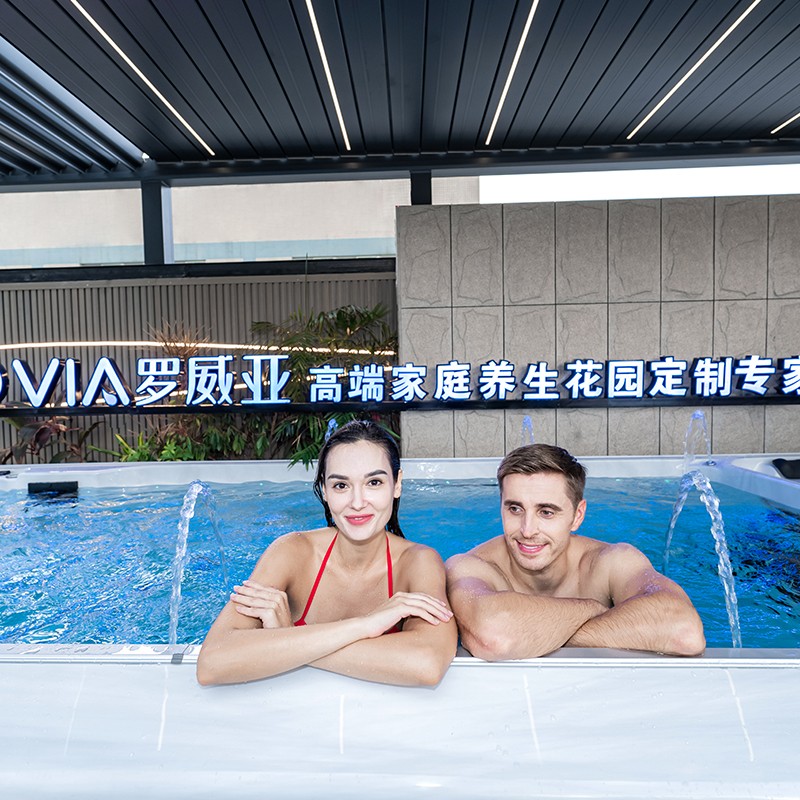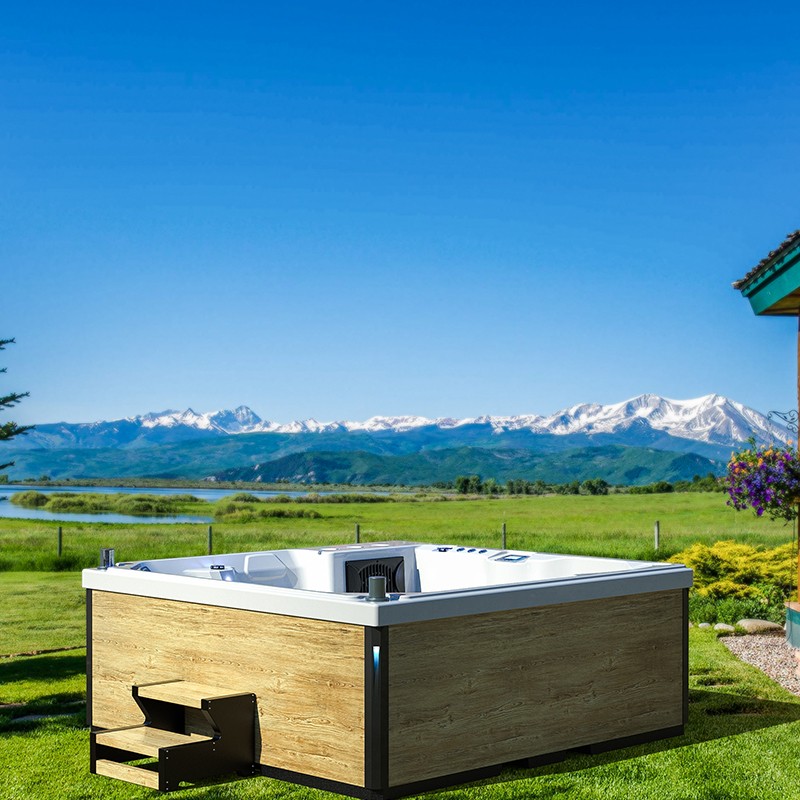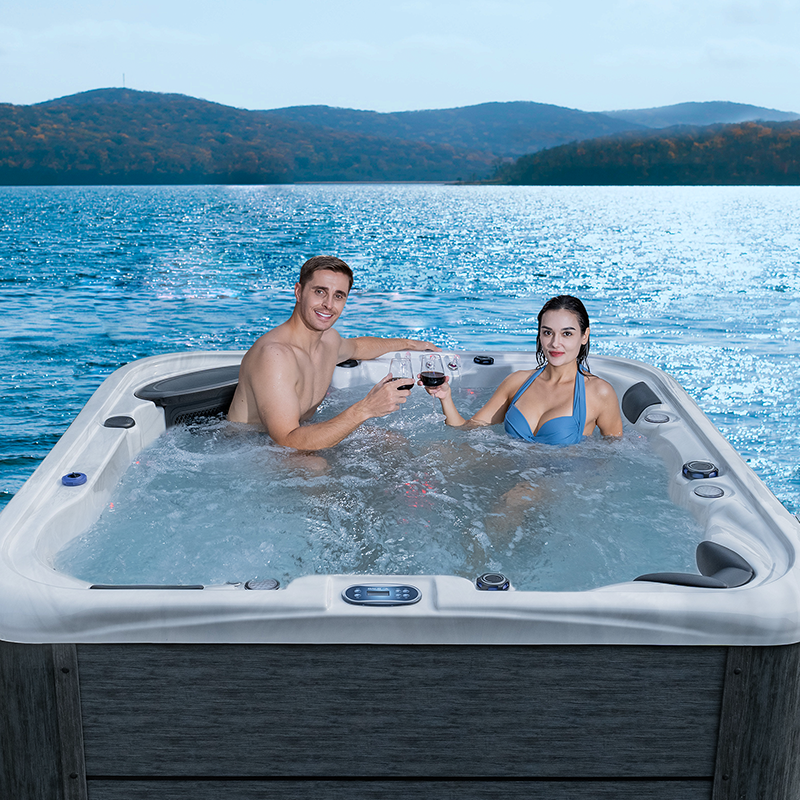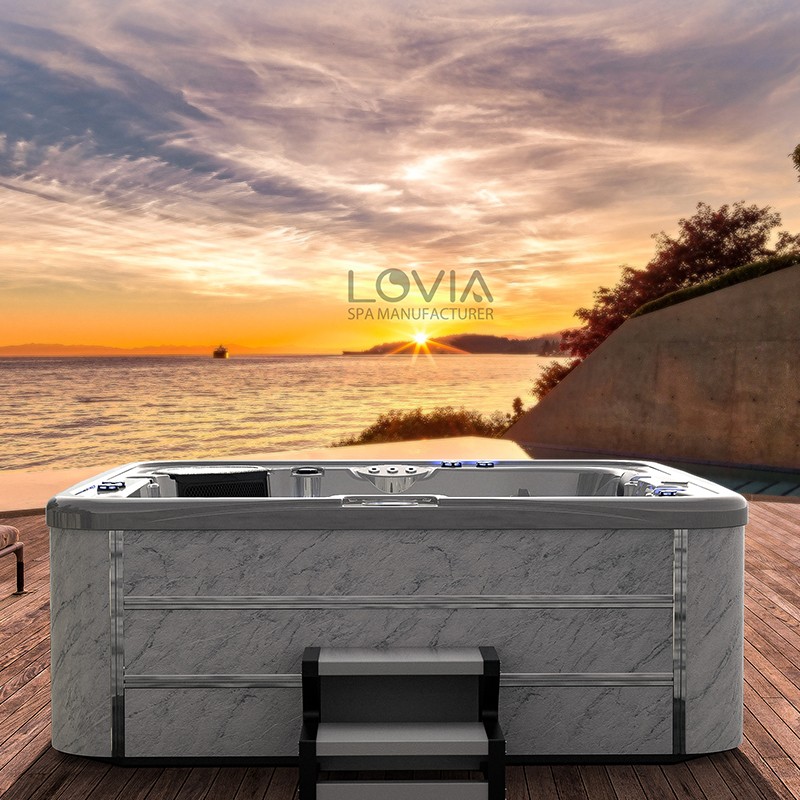
Does your outdoor spa hot tub need to be replaced or upgraded?
2025-07-16 15:35The outdoor spa hot tub not only has the basic bathing function, but also integrates a variety of high-end experiences such as massage, heating, filtration, lighting and bubbles. It is a bathroom product that integrates comfort and technology.
However, any product will have performance degradation, component aging or backward functions after long-term use, and the outdoor spa hot tub is no exception. Therefore, how to judge whether your bathtub needs to be replaced or upgraded is an important issue to ensure family health, safety and comfort experience.
This article will focus on multiple key indicators, from the perspectives of structural aging, electrical system, energy-saving performance, comfort experience, maintenance cost, water quality safety, technical compatibility, etc., to comprehensively analyze when to upgrade or replace the outdoor spa hot tub, and provide practical judgment criteria.

How to judge whether the outdoor spa hot tub needs to be replaced or upgraded?
7 aspects to judge whether the outdoor spa hot tub needs to be replaced or upgraded:
The first aspect: structural integrity and changes in the material of the cylinder
The second aspect: Are the electrical system and control module aging?
The third aspect: Are the heating and insulation systems efficient and energy-saving?
Fourth aspect: Is the spa experience still comfortable?
Fifth aspect: Is the water quality management system efficient and hygienic?
Sixth aspect: Is the cost of use and maintenance rising?
Seventh aspect: Is the compatibility with modern equipment backward?
First aspect: Structural integrity and changes in the material of the tank
1. Is there any cracking, bubbling or discoloration on the surface of the tank?
Most outdoor spa hot tubs are made of fiberglass or acrylic. After a long period of sun and rain, temperature changes and water pressure shock, the surface of the tank may have tiny cracks, fading, deformation, etc. These changes not only affect the appearance, but may also cause water seepage, reduced thermal insulation performance or loose structure.
· Cracks and bubbles are typical signs of aging of the internal structure.
· Fading means that the surface UV protective coating has been weakened and is susceptible to further erosion by ultraviolet rays.
· The deformation of the tank indicates that the supporting structure may be fatigued or the bolts are loose, which poses a safety hazard.
2. Are the edges and joints loose?
If the connection between the edge of the outdoor spa hot tub and the shell, seat or pedal is loose, warped, or debonded, it may be caused by long-term damp heat leading to aging of the bonding, rusting of the bracket, or thermal expansion and contraction.
Judgment suggestion: If there are structural changes or material loss in the cylinder body, it is recommended to conduct a comprehensive inspection to see if it can still meet the safety standards. When there are multiple damages or structural fatigue, replacement should be considered.
Second aspect: Is the electrical system and control module aging?
1. Is the control panel sluggish or the button malfunctioning?
Outdoor spa hot tubs are usually equipped with digital control panels to adjust functions such as temperature, water pressure, nozzle working mode, and lighting. If the control panel has the following phenomena, it means that it has entered the aging stage:
· The buttons are unresponsive or touched by mistake.
· The display is dim, distorted, or flickering.
· The command execution is delayed and the pump starts slowly.
The aging of this electronic control system will directly affect the convenience of use, and there is a safety risk of program operation errors.
2. Is the noise of the motor, heater, or water pump increased?
· Abnormal noises during operation of the outdoor spa hot tub are usually caused by wear of the water pump bearing, motor imbalance or scaling of the heating element.
· Motor aging may cause excessive starting current, affecting circuit stability.
· Heater scaling reduces efficiency, increases energy consumption, and even short circuits.
· Water pump noise indicates damage to the internal impeller or scale blockage.
Judgment suggestions: If the electronic control components fail, energy efficiency is reduced, or there is circuit instability, you should consider replacing the electronic control components or upgrading the entire system.

The third aspect: Is the heating and insulation system energy-efficient?
1. Is the water temperature slow to recover or the constant temperature unstable?
The heating system is the core of the outdoor spa hot tub to maintain a comfortable experience. If you find that the bathtub:
· It takes longer to heat up;
· The water temperature fluctuates greatly;
· Trips or temperature control fails during heating;
It is likely that the heating pipe, water tank or thermostat is damaged or aged.
2. Is there condensation or heat loss on the outer shell or cylinder?
If the surface of the outdoor spa hot tub is still cold when in use, or if you feel that the heat is lost quickly after heating, it may be that the insulation layer has failed. High-quality bathtubs usually use polyurethane foam or double-layer insulation structure, which may lose its original effect over time due to moisture, compression or aging.
Judgment suggestion: A significant increase in energy consumption or a decrease in insulation effect indicates that it is necessary to upgrade to a more energy-efficient model.
Fourth aspect: Is the spa experience still comfortable?
1. Is the nozzle blocked and the water spray is weak?
The nozzle system determines the quality of the massage experience. Over time:
· The nozzle is easily blocked by scale and impurities.
· The spray angle is fixed and lacks multi-mode adjustment.
· The spray force becomes weak and the massage effect is not obvious.
Some old models lack variable air pressure control or adjustable direction, and the experience is relatively simple.
2. Are the lighting, bubbles or aromatherapy systems normal?
Modern outdoor spa hot tubs are often equipped with LED ambient lights, air bubble systems and even aromatherapy infusers to enhance sensory enjoyment. If these functions are unstable, frequently fail, or are not available at all, it means that the equipment is outdated.
Judgment suggestion: If the experience is reduced, the functions are incomplete, or the current comfort needs cannot be met, you should consider upgrading to a more advanced model.
Fifth aspect: Is the water quality management system efficient and hygienic?
1. Is the filtration system unstable or the filter element is frequently replaced?
Water quality is directly related to health. The old filtration system is inefficient and may have the following problems:
· Short filter life and frequent replacement.
· The circulation system is noisy and has a long working time.
· Impurities remain and the water is not clear.
Modern outdoor spa hot tubs are mostly equipped with multi-stage filtration (physical + chemical + biological) systems for more thorough filtration.
2. Does the disinfection system support ozone or UV sterilization?
If you still rely on manual chlorination or bleach disinfection, it is not only cumbersome to operate, but may also irritate the skin and respiratory tract. At present, high-quality models widely use automatic disinfection methods such as ozone/ultraviolet rays/silver ions, which are both safe and efficient.
Judgment suggestion: Difficulty in water quality management or backward filtration and sterilization function indicates that the system needs to be upgraded.

Sixth aspect: Is the cost of use and maintenance rising?
1. Is the electricity and water bills increasing significantly?
After the bathtub ages, the following often occur:
·Decrease in heating efficiency, and it takes longer to reach the temperature;
·Increase in the frequency of circulation;
·Frequent water changes;
·Long equipment downtime.
These will lead to increased indirect costs.
2. Are parts frequently repaired and difficult to purchase?
Models that have exceeded a certain age may face problems such as discontinuation of parts, long maintenance cycles, and high labor costs. Although the cost of each repair is not high, the cumulative cost is far more than replacing the entire machine.
Judgment suggestion: If maintenance is frequent and the cost is rising, upgrading to a new model that is more energy-saving and low-consumption is a more economical choice.
Seventh aspect: Is the compatibility with modern equipment backward?
1. Does it have intelligent linkage and remote control functions?
Hyundai outdoor spa hot tub widely supports Wi-Fi connection, App remote control, voice assistant linkage and other functions. For example, remote heating, scheduled start, status monitoring, etc.
The old models lack these intelligent functions, which is not only inconvenient to use, but also not conducive to energy regulation and safety management.
2. Does it support modular expansion?
Advanced bathtubs can support modular upgrades, such as:
· Add bubble seats;
· Install Bluetooth speakers;
· Add sun protection top covers;
· Expand children's mode or physiotherapy programs.
If the old models cannot be expanded, the function update is limited.
Judgment suggestion: For outdoor spa hot tubs that lack compatibility and upgrade space, it is recommended to replace them in time to adapt to the new needs of the family.

Outdoor spa hot tub: Comprehensive judgment and replacement suggestions
Based on the above seven aspects, the following judgment criteria can be formulated:
| Judgment Dimensions | Specific manifestations | Recommended measures |
| 1. Structural aging | Cracks on the cylinder body, falling edges | Replace the whole unit |
| 2. Control system | Panel failure, slow response | Replace the control module or upgrade the whole unit |
| 3. Heating and insulation | Slow heating, unstable temperature | Replace the heating element or the whole unit |
| 4. Spa experience | Weak massage, damaged lights | Upgrade to a new multi-functional model |
| 5. Water quality system | Unclear water, frequent filter failures | Upgrade the filtration and disinfection system |
| 6. Cost of use | High cost, many faults | Consider replacing an energy-saving model |
| 7. Technical compatibility | No support for smart functions | Upgrade to a smart bathtub |
Are your spa products energy efficient?
Yes, energy efficiency is a priority in our spa product design. Guangzhou HuanTong Industrial incorporates the latest insulation materials, energy-saving pumps, and intelligent temperature controls to ensure our spa jacuzzi tubs and swim spas consume minimal power. These features not only reduce environmental impact but also lower operating costs for end users. Choosing our high quality spas means investing in products that meet global eco-standards and deliver excellent value over time.
